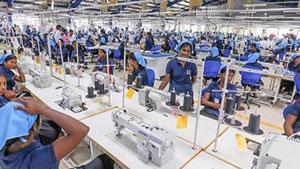 By Nishel Fernando
By Nishel Fernando
The Joint Attire Affiliation Discussion board (JAAF) careworn that the official garment employee minimal wage doesn’t paint an correct picture of the full earnings of a garment employee in Sri Lanka.
Responding to a latest article printed on Simply-Type, JAAF Common Secretary Yohan Lawrence identified that the present two-tiered system of a hard and fast primary wage is complemented by productivity-based funds together with different non-cash advantages.
The Clear Garments Marketing campaign, the worldwide alliance of labour unions and nongovernmental organisations, claimed that Sri Lanka’s garment {industry} minimal wage pay scale generally has “didn’t cowl a employee household’s wants, resulting from excessive inflation”.
In March this 12 months, the federal government elevated the nationwide dwelling wage by 40 %, from Rs.12,500 (US $ 42) to Rs.17,500 (US $ 59) per 30 days, on prime of a Rs.3,500 budgetary reduction allowance, bringing the full minimal month-to-month pay to Rs.21,000 (US $ 70). In the meantime, the attire sector’s industry-agreed minimal wage, together with the federal government budgetary allowance, stands round Rs.24,000 (US $ 80).
“The article refers back to the nationwide minimal wage, which covers the mounted month-to-month element of worker earnings (the worker’s primary wage). While the nationwide minimal wage was elevated after a few years, the businesses will evaluate the essential wage yearly. They are going to, relying on their capacity to pay, enhance this primary wage on an annual foundation.
The article sadly doesn’t make any reference to both the variable parts of whole earnings (that are paid in money) or to any of the non-cash advantages afforded to the workers,” Lawrence responded.
The money advantages embody gadgets similar to manufacturing bonuses, attendance allowances, annual bonuses, skill-based funds and extra time.
“This two-tiered system of a hard and fast primary wage, complemented by productivity-based funds, has been the norm in all manufacturing industries, each regionally and globally,” Lawrence added.
Along with these money funds, the {industry} additionally supplies non-cash advantages similar to subsidised meals and transport.
He additionally famous that a number of corporations additionally present subsidised or free dry rations (one thing that was began on the peak of the financial disaster and continues even at this time) or produce other related schemes to ease the burden of the price of dwelling on the workers.
Subsequently, he argued that it’s unfair to evaluate the precise stage of earnings of the workers merely based mostly on the essential wage.
As well as, Lawrence famous that inflation has come right down to single digits since early 2023, after peaking to double digits in 2023, thereby, decreasing the inflationary impact on the actual wages.
In the meantime, the JAAF stays assured of reaching US $ 4.5 billion in attire export earnings this 12 months, regardless of the challenges.

